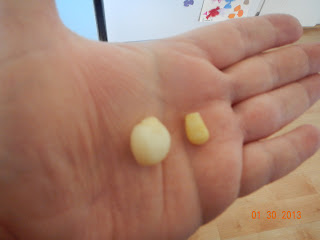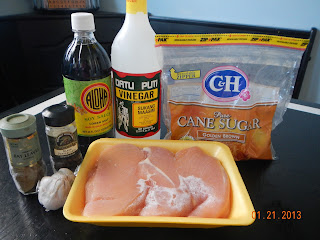Guinea pig anyone?
I'm not being very culturally sensitive am I? I'm sure that Cuy, the national dish of whole roasted guinea pig (head and feet intact) is very tasty. I just can't wrap my spoiled American head around it. To me, Guinea pigs are pets not party food. So scratch one recipe off the list, hmmm, what should we make? The cuisine of Peru has many diverse influences - the Incas and other native peoples, the Spanish, Africans and the European traders and Chinese and Japanese immigrants to name a few. The main staple of the diet is potatoes, or "papa", which are native to Peru and have been grown in the Andes for thousands of years. They have thousands of different varieties. They also eat a lot of rice and hot peppers called "aji". If you really want to recreate an Incan dish you could cook it "pachamanca" style. You put meat, potatoes, some vegetables like Peruvian corn and some REALLY HOT rocks in a cooking vessel and let the rocks do the cooking! The Mongolians had a similar dish with hot rocks in a goat. I do have a lot of rocks left over from Zimbabwe's balancing rocks but that seems like a lot of work. So I found a recipe on the internet. I love the internet. Here it is.............
Lomo Saltado
For the recipe you will need:
- 2 lbs. tender beef- cut into strips. The butcher recommended a top sirloin and even sliced it for me :)
- 1 red onion- cut into strips
- 1 can (15oz) diced tomatoes- drained
- 1 jalapeno or, if you can find it, aji amarillo pepper - sliced and seeded. I found them frozen at the Latin market.
- 1/4 cup fresh cilantro- chopped
- 4 potatoes- cut into strips like fries
- 1 tsp paprika

- 1 1/2 Tbsp crushed garlic
- 1/2 tsp salt
- 2 tsp cumin
- 1 1/2 tsp ground black pepper
- 2 Tbsp rice vinegar
- 2 Tbsp soy sauce
- 2 Tbsp canola oil
2. Heat some (about 2 tsp) oil in a large fry pan and cook marinated steak until browned.
3. Add tomatoes and simmer for a few minutes
4. Add marinated onions, cilantro and hot pepper to the pan and cook until everything is cooked though. It smells so delicious!!
5. While that is cooking, sprinkle the potatoes with paprika and a little salt and fry in a separate pan. That's the traditional way- I coated mine with oil and roasted them in the oven.
6. Combine the crispy potatoes with the other ingredients. Traditionally this is served with a dish of white rice as well.
 Ok, I know I claim that every dish is really good, but this is REALLY GOOD! The marinade is awesome and the meat was so tender. I love onions so they were delicious, but my husband and kids picked them out. The tomatoes kind of melted into the sauce and the aji amarillo peppers had a bit of heat but I think a jalapeno would have been hotter. The carbs seemed a bit overdone and I personally would have like it better with the rice instead of the potatoes. The paprika on the potatoes was yummy- never tried that before.
Ok, I know I claim that every dish is really good, but this is REALLY GOOD! The marinade is awesome and the meat was so tender. I love onions so they were delicious, but my husband and kids picked them out. The tomatoes kind of melted into the sauce and the aji amarillo peppers had a bit of heat but I think a jalapeno would have been hotter. The carbs seemed a bit overdone and I personally would have like it better with the rice instead of the potatoes. The paprika on the potatoes was yummy- never tried that before.  We found some frozen Peruvian corn at the market too. Have you ever seen Peruvian corn? It's huge! A normal kernel of corn is about the size of a tooth, right? Well, a kernel of Peruvian corn is the size of a dime. It had a much different texture though, it was more starchy and not as flavorful. I personally didn't care much for it. We also had a very interesting dessert - Purple Corn pudding, called Mazamorra Morada. I'm sure the version we had was not very authentic since it was boxed like jello and used a lot of artificial flavors, but it was something different to try.
We found some frozen Peruvian corn at the market too. Have you ever seen Peruvian corn? It's huge! A normal kernel of corn is about the size of a tooth, right? Well, a kernel of Peruvian corn is the size of a dime. It had a much different texture though, it was more starchy and not as flavorful. I personally didn't care much for it. We also had a very interesting dessert - Purple Corn pudding, called Mazamorra Morada. I'm sure the version we had was not very authentic since it was boxed like jello and used a lot of artificial flavors, but it was something different to try.  And boy was it something different - it was like warm purple slime with pineapple chunks. I know that sounds disgusting but it tasted good. It had clove and cinnamon flavors and pineapple (suggested on the box). My son loved it and ate two small bowls. I would love to try the real thing to be able to compare! And I was so excited to find another purple food - apparently only America has this purple food shortage! I'd love to hear your comments if you try some of the dishes. Don't let the multi-step recipe scare you - I would skip the potatoes and just serve it with the rice, or vice versa.
And boy was it something different - it was like warm purple slime with pineapple chunks. I know that sounds disgusting but it tasted good. It had clove and cinnamon flavors and pineapple (suggested on the box). My son loved it and ate two small bowls. I would love to try the real thing to be able to compare! And I was so excited to find another purple food - apparently only America has this purple food shortage! I'd love to hear your comments if you try some of the dishes. Don't let the multi-step recipe scare you - I would skip the potatoes and just serve it with the rice, or vice versa.Enjoy!!!!!





















































